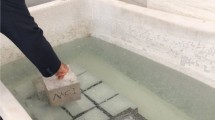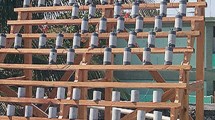Abstract
There are many different test methods to assess reinforced concrete durability. As in marine environment reinforcement corrosion due to chloride attack is the most important degradation process, chloride penetration rate has been compared with different durability tests results (concrete strength, porosity, water absorption, water penetration depth under pressure, capillarity, water and oxygen permeability) carried out on concrete cores obtained from the caissons of seven Spanish wharves. Data have been studied separately, depending on concrete location (chloride penetration rate is faster in submerged concretes than in tidal zone concretes) and cement type (mineral admixtures reduce permeation rate due to pore size refinement). Results show that it is advisable to control concrete water tightness through water penetration under pressure test; additionally, in order to make sure a slow corrosion rate, it should be advisable to control oxygen permeability in tidal zone concretes.




















Similar content being viewed by others
References
Ministerio de Fomento (1998) Instrucción de Hormigón Estructural: EHE. Madrid
CEN (2002) Eurocode 2: Design of concrete structures – Part 1: General rules and rules for buildings. prEN 1992-1-1(Revised final draft). Brussels, April
ACI (2002) Building Code Requirements for Structural Concrete. ACI 318R. In: ACI Manual of Concrete Practice 2002 Part 3. Design and Construction Practices. Detroit
CEB (1989) Durable concrete structures. CEB Design Guide. Bulletin CEB no 183. Lausanne
ACI (2002) Protection of metals in concrete against corrosion. ACI 222R. In: ACI Manual of concrete practice 2002 Part 1. Materials and general properties of concrete. Detroit
Costa A, Appleton J (1999) Chloride penetration into concrete in marine environment – part I: Main parameters affecting chloride penetration. Mater Struct 32(218):252–259
Bamforth P (1997) Probabilistic performance based durability design of concrete structures. In: Byars EA, McNulty T (eds) Management of concrete structures for long-term serviceability. Proceedings of the Int. Seminar. Sheffield, UK
Valenta O (1970) The permeability and durability of concrete in aggressive conditions. In: Proceedings of Tenth International Congress on Large Dams. Montreal
BRE Centre For Concrete Construction (2000) Corrosion of steel in concrete. Digest 444 (parts 1 to 3). London
Sarja A, Vesikari E (eds) (1996) Durability design of concrete structures. RILEM Report 14. RILEM
Goltermann P (2003) Chloride ingress in concrete structures: extrapolation of observations. ACI Mater J, March–April:114–119
Mehta PK, Gjorv OE (1982) Properties of portland cement concrete containing fly ash and condensed silica fume. Cement Concrete Res 12:587–595
Sherman MR, McDonald DB, Pfeifer DW (1996) Durability aspects of precast prestressed concrete. Part 2: chloride permeability study. PCI J 41(4):76–95
Acknowledgements
The authors wish to thank the financial support given by Ports of Spain. Thanks to General Directions of CEDEX for initiatives to promote postgraduate training and development of doctoral thesis. Thanks to College of Civil Engineer for all the support at all stages during the preparation of this experimental study.
Author information
Authors and Affiliations
Corresponding author
Rights and permissions
About this article
Cite this article
Bermúdez Odriozola, M.Á., Alaejos Gutiérrez, P. Comparative study of different test methods for reinforced concrete durability assessment in marine environment. Mater Struct 41, 527–541 (2008). https://doi.org/10.1617/s11527-007-9263-8
Received:
Accepted:
Published:
Issue Date:
DOI: https://doi.org/10.1617/s11527-007-9263-8




